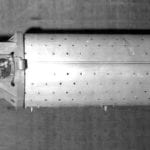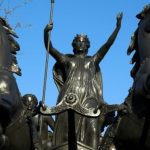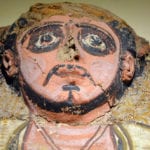 Our World
Our World  Our World
Our World  Weird Stuff
Weird Stuff 10 Fascinating Facts You Might Not Know About Snow
 Miscellaneous
Miscellaneous Top 10 Things Crypto Was Supposed to Change & What Actually Did
 History
History 10 Huge Historical Events That Happened on Christmas Eve
 Music
Music 10 Surprising Origin Stories of Your Favorite Holiday Songs
 History
History 10 Less Than Jolly Events That Occurred on December 25
 Weird Stuff
Weird Stuff 10 Funny Ways That Researchers Overthink Christmas
 Politics
Politics 10 Political Scandals That Sent Crowds Into the Streets
 Weird Stuff
Weird Stuff Ten Bizarre Facts About The Doge Meme
 Our World
Our World 10 Ways Your Christmas Tree Is More Lit Than You Think
 Our World
Our World 10 Archaeological Discoveries of 2025 That Refined History
 Weird Stuff
Weird Stuff 10 Fascinating Facts You Might Not Know About Snow
 Miscellaneous
Miscellaneous Top 10 Things Crypto Was Supposed to Change & What Actually Did
Who's Behind Listverse?

Jamie Frater
Head Editor
Jamie founded Listverse due to an insatiable desire to share fascinating, obscure, and bizarre facts. He has been a guest speaker on numerous national radio and television stations and is a five time published author.
More About Us History
History 10 Huge Historical Events That Happened on Christmas Eve
 Music
Music 10 Surprising Origin Stories of Your Favorite Holiday Songs
 History
History 10 Less Than Jolly Events That Occurred on December 25
 Weird Stuff
Weird Stuff 10 Funny Ways That Researchers Overthink Christmas
 Politics
Politics 10 Political Scandals That Sent Crowds Into the Streets
 Weird Stuff
Weird Stuff Ten Bizarre Facts About The Doge Meme
 Our World
Our World 10 Ways Your Christmas Tree Is More Lit Than You Think
10 Amazing Innovations Developed by the Inca Empire
The Inca empire thrived across the Andean region of South America for centuries after first rising up at some point in the 13th century. Known to others in the centuries after that, and later encountered by European explorers first visiting South America and the New World, the Incas impressed all around them with their advanced society. At the height of their reign through the 1300s, 1400s, and into the 1500s, their territory contained major parts of modern-day Peru, Chile, Bolivia, and Ecuador. And they very much knew how to use the land and its resources to their benefit.
It’s tempting to think that all the innovation in the ancient world came from Europe, the Middle East, and the Far East, but the Incan people proved that simply wasn’t true. From inventive societal set-ups to impressive engineering accomplishments, the Incas dominated South America for ages. They were experts at living at high altitudes during the height of their flourishing reign and proved it in the innovations they left behind. In this list, let’s take a look at ten of those impressive innovations and the legacy they now leave on modern-day society.
Related: Ten Bizarre Discoveries about Ancient Civilizations and Our Ancestors
10 The Great Inca Road
Life changed in the United States after World War II when the interstate highway system was developed and built. Suddenly, it was easier than ever for people to travel long distances in an efficient manner by car. In time, it connected disparate parts of the United States in ways never before thought possible, improving commerce, communication, and more. But the U.S. highway system was far from the first one implemented by a major Western empire—it was just the first one since Henry Ford invented the automobile.
Centuries before American interstate culture, the Incans developed what has come to be known as the Great Inca Road. Also called Qhapaq Ñan—technically the Road of the Inka—this was a system of nearly 25,000 miles (40,233 kilometers) of graded roads that connected every part of the Incan empire together.
This development allowed Incan rulers to easily send out officials to control and administer far-flung reaches of the empire. It made commerce significantly easier for the time, with a relatively flat and steady road always nearby to take goods to different cities. And it allowed the Incan empire to communicate from region to region even amid mountainous terrain and what would otherwise be inhospitable conditions.
Even today, historians, archaeologists, and civil engineers alike marvel at the impressive accomplishment. With the tools they had at the time and the manpower it would have required to build out thousands of miles of open roads, the Incans achieved a massive success. In turn, the effectiveness of the road no doubt helped their empire thrive for as long as it did.[1]
9 Amazing Machu Picchu
Machu Picchu is, of course, the now-iconic Inca creation that sits way up high in the Andes Mountains. It was first built way back in the 15th century and was meant to serve as a royal estate for Incan emperors. Today, it remains not quite as it once was, but as a very renowned world archaeological site, with many thousands of visitors each year. That’s not the impressive story with the UNESCO World Heritage site, though; its 15th-century innovations concerning architecture, engineering, and drainage are what really turn heads.
See, the area where Machu Picchu was built sees, on average, about 80 inches (203 cm) of rain every year. And since it’s so high in the sky, the altitude, steep slopes, and common landslides make both building and drainage very difficult. But the Incans figured out how to get all that water drained safely and consistently from the area—and several hundred years before civil engineers were a thing in other parts of the world. To do that, the Incans created a series of stone walls that filter water through highly specific routes away from the citadel and down the mountain.
All that water is then funneled down into a canal, which runs several thousand feet down into a pond. That pond allows for the permanent collection of this constant rainwater, which not only keeps the water itself from—among other things—causing landslides all over the hillside where people live, work, and commune. More importantly for sustainability, it allowed the Incas to have a reliable, consistent freshwater source from which they could get drinking water. That all this stands as strongly as it did hundreds of years ago (and after being abandoned several hundred years after it was built!) proves that Incan innovation was built to last.[2]
8 The Code of Quipu
The Incan empire devised a very secretive, complex, and effective way to record information and send out communications to faraway reaches of their land. The system was called “quipu,” and it’s a code that we still haven’t quite figured out in the modern era. Quipus were basically knotted cords and strings of different colors. They were knotted and ordered in such a way, and with certain colors in specific orders, that conveyed information quickly and correctly to the “reader” of that coded message.
These knotted cords could be sent to someone miles away, and upon being received, the message meant from the order of the knots could be understood and carried out. Think of it like smoke signals or sign language, but with colored cords to tell the tale. It’s most likely these quipus were set up and sent out to convey governmental administration needs, accounting and logistical demands, and likely even battle plans for warriors.
But as we noted, historians today haven’t been able to decipher what colors corresponded with what messages. So, it’s likely that quipu codes will remain with the ancient Incas for eternity, never to be revealed to the rest of the world. In that way, the coded cords did their job, for non-Incan observers still haven’t figured out what they are “saying”![3]
7 Taking on rhe Terrace
Because the Incas lived on such high mountain plateaus, they needed to get creative with how they approached farming and food production. They didn’t have vast expanses of flat, rich land like many other people around the world. And they didn’t have access to jungles, forests, oceans, or places where they could conceivably hunt some type of consistent game. So they had to work with what they had: high hills, craggy cliffs, and steep steppes. And they succeeded in making food in those places with one important innovation: terraced agriculture.
Of course, the Incas weren’t the only people in the ancient world to use terraced agricultural practices. But they had no idea what was going on in Asia and other faraway points around the globe. Thus, in their region, the Incan move to terrace their hillside land was truly pioneering.
They used stones and other manmade blocks to create stepped platforms that ran in rings along the hillsides. They basically created flatlands on the hills—just in very small, parceled-out pieces. The end result was what mattered, though, and the terraces worked. By cultivating flat, rich terrain out of what had previously been just a hillside, the Incas were able to sustain their civilization for centuries.[4]
6 Masonry Marvels
The Incas were masterful stone masons in their time. As we’ve seen with their terraced agricultural work, they would carve out stones and position them in large blocks to help keep terraces upright and flat for farming. But even beyond that, their stonework was seen all over their empire. The impressive detail and incredible engineering work done to carve down and carefully fit together stones was a true marvel—especially because the Incas lacked modern tools to easily move the massive rocks around as needed.
Even without the use of modern technology, though, the Incas figured out how to fit together huge stone blocks by using mortar. The mortar they created allowed stone structures to stay standing for centuries. In fact, many of these structures are even still standing (or partially standing) today.
Considering how much time has passed since they were created, that’s certainly quite an achievement. Sites like the still-standing walls of Sacsayhuamán make modern tourists marvel at how ancient people could have possibly fit together massive stones weighing hundreds of tons each. But the Incas did it—and built it to last.[5]
5 Suspension Bridge Success
Because the Incan empire was set up so high in the Andes, traversing large distances was difficult. Unlike many places around the globe with (relatively) flat terrain and the ability for people to walk long distances over time, the Andes were jagged and challenging to cross. So instead of just being content to slowly trek all the way up one hillside and all the way down the next to get places, the Incan people got creative. And for them, this creativity meant designing remarkably advanced suspension bridges!
While we take suspension bridges for granted in the modern era, these designs from centuries ago were incredibly intricate and, amazingly, quite structurally sound. They were called “Q’eswachaka,” and they were made out of tightly interconnected grass and fibers. When these materials were woven together, they allowed for the bridge to hold a considerable amount of weight. So people were able to cross them with regularity.
Just like the Great Inca Road that we’ve already learned about, the bridges were critical in connecting mountain communities that would have otherwise been remarkably isolated high up on hillsides. They allowed for better commerce, more efficient transportation, and improved logistics for the entire empire to run more smoothly.[6]
4 Wonderful Weavers
The Incas were incredibly skilled weavers. Even beyond the intricate and critical weaving, they did to create their suspension bridges that soared high into the sky, they weaved a variety of textiles and used an assortment of weaving techniques that were groundbreaking for the time period. They had quite a selection of materials from which to weave, too, including alpaca and vicuña wool. Those choices allowed them to construct some seriously hardy clothing, shawls, blankets, and an assortment of domestic items that could stand the test of time.
By using their weaving skills to produce so many pieces, the Incas could stay warm and safe in the sometimes cold, high-altitude temperatures. They could also effectively trade for other goods with nearby civilizations should the Inca people need things that weren’t available in their high-mountain locale. And, of course, the cultural impact of their weaving skills can’t be underestimated. Still today, Incan weaving is seen as one of the peak times of textile use and handmade creation in all of human history.[7]
3 Astrological Expertise
The Incas believed that the entire universe was connected through the solar system. The sun and moon were considered gods by those people, as was the case in many cultures around the world. But beyond the religious aspects of their belief system, the Incas had surprisingly intricate (and accurate) time markers involving the stars, the planets, and the moon. For one, the Incas were able to identify specific constellations, categorize them as either light or dark, and track them through the sky with accuracy on an annual basis. And beyond that, they quickly figured out that the sky could give them reliable signs regarding agricultural moves and crop planting schedules.
See, the Incas created structures that were built in very specific positions. In those positions, the angle of the sun hitting the stone structures in a specific spot would let them know when it was time to start planting, stop planting, harvest food, or store it for the winter. They could also track these things based on the sun’s slow but reliable movement as its rays shone across the mountain peaks around their homes.
When the sun rushed through two peaks in a certain way and hit a certain point on the other side of the mountain, the Incas knew the time had come for a particular agricultural adjustment, be it planting or harvesting. So, even though they may not have had calendars like we know them or clocks like we have come to rely on, they knew exactly what time it was.[8]
2 A Powerful and Motivated Military
At the height of their power across their region of South America, the Inca boasted a highly skilled, highly motivated military force. They were known as Sapa Inca’s army, named so for the “Sapa Inca,” who was the absolute ruler and emperor of the land. As the Incas accumulated power, territory, and new communities under their direction, they added to their army. In time, it became a remarkably powerful fighting force. They were armed to the teeth, and their warriors were highly trained to fight off any incursions into their land.
More than just a show of military might, though, Sapa Inca’s army was important for several other reasons, too. For one, the army was regularly used to push forward progress on the economic and logistical development of the Incan empire. The Sapa Inca recognized rightly that the land needed significant public works—like the Great Inca Road and the suspension bridges that we’ve already learned about in this list.
So the ruler required his armed forces to work on building out things like that for the empire’s greater good. Having that much manpower to use on public works projects proved critical for Incan success and innovation. Were it not for the sheer amount of military might and influence they had, the Incas would not have completed as many lasting projects as they did.[9]
1 The Inca Runners
With the Great Inca Road built out and with suspension bridges spanning large chasms and linking open gaps, the Incas had the pieces in place to have a remarkably interconnected culture. They just needed one more thing to make it work: cars. Just kidding! They didn’t have that and, obviously, would never get that during their reign in the ancient world. But without motor-propelled power to deliver goods, messages, and more to faraway parts of their land, the Incas needed human power to do the job. Enter: chasquis. These chasquis were highly trained, extremely fit young men who served as runners between difficult-to-reach Incan communities.
Chasquis were tasked with taking a message from a sender and running off across the land. They would run down the Great Inca Road, cross various suspension bridges, and run up and down arduous mountain trails and over rocky, hilly outcroppings. When they hit their limit, they would hand their message off to the next chasqui, who would take it and continue the journey as fast as they could to get the item to its destination.
Archaeologists today estimate these chasquis covered dozens of miles per day—or more. They carried things from messages to even lightweight goods like fish or other small items. And with their long runs and quick paces, they kept the Incan empire better connected than most civilizations of that time period.[10]








